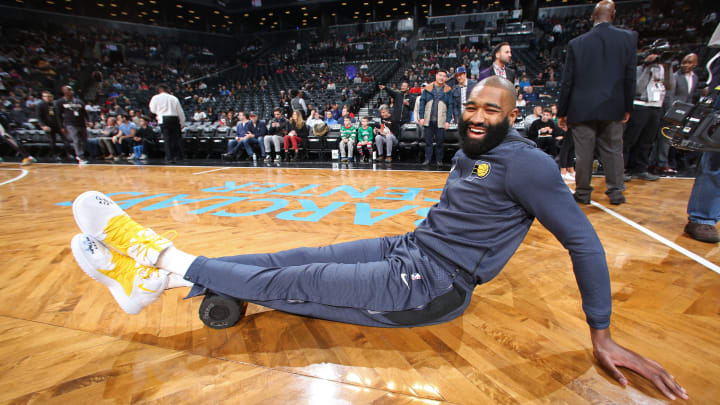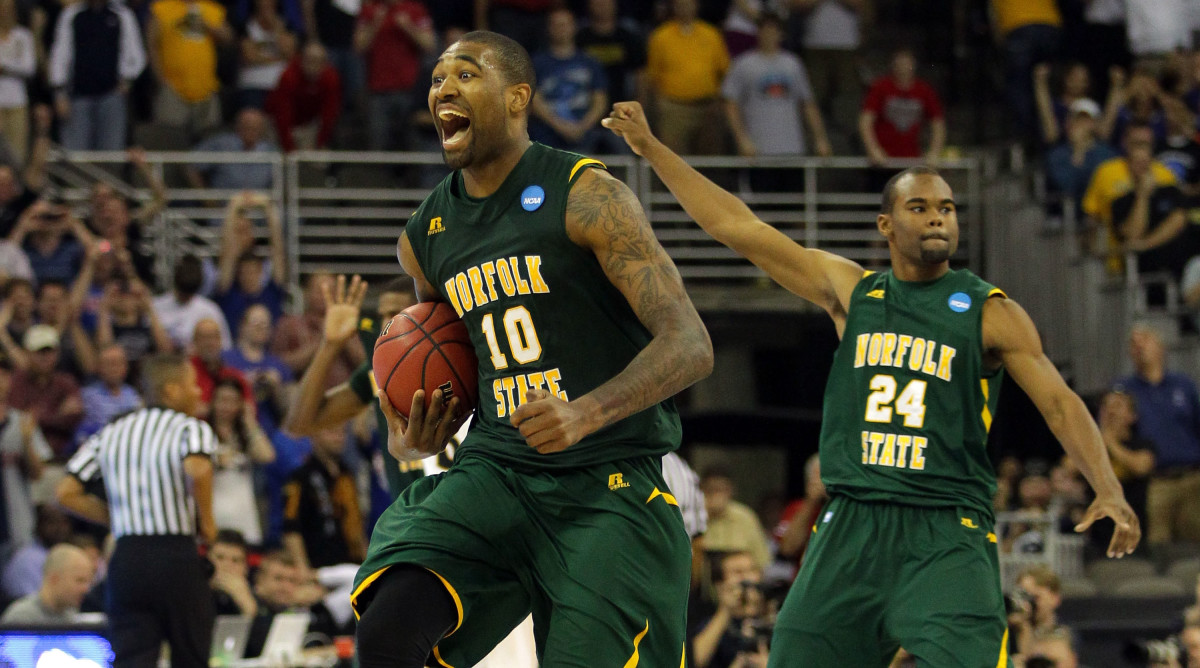Kyle O'Quinn's Road to Becoming One of the NBA's Rare HBCU Alums

It didn’t take long for Robert Jones to see something special in Kyle O’Quinn.
He attended a Campus Magnet High School basketball game, located in Cambria Heights, N.Y., which had a big man on its roster with quick feet, a sweet shooting touch and an intimidating defensive presence. Jones, now the head coach at Norfolk State University in Norfolk, Va., stepped foot in the gym and had his eyes peeled on the skilled senior from Queens, N.Y. Jones was an assistant on Norfolk State’s coaching staff at the time, and he found the right guy to become his first recruit for the program.
“I got a tip on Kyle from one of my New York connections,” Jones told me. “I saw he was at the top of the press, impressive for a kid 6'8" (O’Quinn eventually grew to 6’10”), running around creating traps, and he was shooting 15-16 footers, which is also impressive for a high school kid at his size. Those things really intrigued me right away.”
FISCHER: These Press Conferences Can Be Awkward for Role Players
Jones was fresh off spending two years as the head coach of Saint Mary’s High School in Manhasset, N.Y., where he led his team to a 32-15 record in two seasons while competing in one of New York’s highest classifications (Class AA). Being from Queens himself, he had ties to the area and was intent on making an immediate impact at Norfolk State, a Historically Black College University.
He was just 28 at the time, but Jones knew adding a player of O’Quinn’s caliber would give Norfolk State someone to build the program around.
“To get a kid like that was a steal for us,” Jones said. “It just kind of baffled me that a kid averaging that many points, that many rebounds playing in New York City, didn’t have many offers. But I made sure I was the first one.”
O’Quinn was born and raised a New Yorker, a state widely recognized for its talent on the basketball scene, but he was a late bloomer. He didn’t play until his junior season, and as a senior averaged 20 points and 12 rebounds while leading Campus Magnet to a 24-5 record, a divisional championship and a trip to the quarterfinals of the city tournament.
When Jones presented O’Quinn with the option to play college basketball on a Division I stage, it was an offer he couldn't refuse. For more than one reason—it was also his only offer.
“There was very limited interest,” O’Quinn said. “And then Norfolk State came in with a full scholarship, and that pretty much made the decision for itself.”
O’Quinn immediately made his presence felt at Norfolk State, and became a full-time starter as a sophomore. He was named the Mid-Eastern Athletic Conference Defensive Player of the Year his junior season, when he was fourth in the nation by averaging 3.4 blocks per game. He then turned around and won both Defensive Player of the Year and MEAC Player of the Year as a senior in 2011-12, becoming the first in the conference’s history to take home both honors in the same season.
He averaged 15.9 points, 10.3 rebounds and 2.7 blocks per game that year, and led the Spartans to their first MEAC tournament title in school history. That also meant an automatic bid to the NCAA tournament—another first in the school’s history—which gave O’Quinn the opportunity to showcase his talent in front of a nationally televised audience.
Norfolk State was a 15 seed and was matched up against two-seeded Missouri, which was a 21.5-point favorite entering the contest. O’Quinn had one of his most impressive outings of the season, putting up 26 points and 14 rebounds while leading the Spartans to a highly unlikely upset, which shocked the college basketball world.
It was one of just eight occasions where a 15 seed topped a two seed. It happened twice that year, as Lehigh, led by now-Portland Trail Blazers guard CJ McCollum, also defeated Duke in the Round of 64.
“My life wouldn’t have turned out this way if we would’ve lost that game,” said O’Quinn. “It’s crazy how much one game can affect your career, and I think that it helped shape my life and my family’s.”

O’Quinn rode that wave to the NBA draft, where he was selected by the Orlando Magic with the 49th overall pick in 2012. He’s currently on a one-year deal with the Indiana Pacers after spending three seasons in Orlando and three in his hometown playing for the New York Knicks. O’Quinn, who has a smile big enough to light up Times Square and is well respected in NBA circles, said he finds himself “bragging” at times amongst his peers, in locker rooms and such, because a lot of players want to know what it was like to grace an HBCU campus. But not many in the league can relate.
“It’s a one-of-a-kind experience,” said O’Quinn. “I think kids at the bigger schools, they really miss out on the true college experience by not going to an HBCU.”
O’Quinn is one of two active players currently on an NBA roster to attend a historically black college. The other is Minnesota Timberwolves forward Robert Covington, who played his college ball at Tennessee State in Nashville.
Covington had a different path, however, after not getting drafted in 2013, joining the Houston Rockets’ Summer League team and making an impact on their D-League affiliate, the Rio Grande Valley Vipers. He performed well enough to appear in seven games for the Rockets that season before getting cut in the summer of 2014. He was soon after signed by the Philadelphia 76ers. Covington spent four full seasons in Philly before being traded for Jimmy Butler and sent to the Timberwolves, eventually carving out a role as one of the NBA’s top three-and-D wing players.
“You always pull for guys from not just HBCUs, but from smaller-conference schools,” O’Quinn said. “Like the CJ McCollum's, you look at those guys and you always root for them to do well, just like they want to see you do well—from a small school proving yourself in the NBA.”
O’Quinn remains the last player from an HBCU to be drafted since David Young, who attended North Carolina Central, was selected in 2004 but never appeared in an NBA game. Before Young, it was Ronald “Flip” Murray out of Shaw University in 2002. He played for eight different teams and started a total of 92 games during his eight-year NBA career.
O’Quinn was the first player taken from Norfolk State since Lee Johnson in 1988, who also never made an NBA appearance.
After three years in Orlando, O'Quinn's stint in New York didn't start the way he hoped. He lost his father, Tommie O’Quinn, to a car accident in 2015, just months before he made his Knicks debut in his hometown. He admired his dad, who was there each step of the way, watching his son progress through college, win a conference championship and defy odds by being drafted into the NBA.
“God had a plan,” Kyle said. “He brought me back [to New York] at the right time to bring the family together. I needed them, they needed me.”
Kyle, who will be 29 on March 26, recognizes the role his loved ones have played leading up to this point. So when Norfolk State honors his illustrious college career by retiring his No. 10 jersey on Feb. 16, when the Spartans host North Carolina Central, Kyle wants to dedicate the ceremony to those who matter most.
SI TV: Kemba Walker Opens Up About His Connection to Charlotte
“It’s going to be a good feeling,” he said. “I think it’s most important for family. Draft night was all about me, me graduating college was all about me, but when you put that jersey up, it’s a lot about the people around me and everybody that had a hand in it.”
O’Quinn returns to Norfolk State each summer to help conduct a camp, which keeps that magical NCAA tournament run fresh in the minds of the Spartan players. Coach Jones currently has his team leading the pack in the MEAC and on pace to make another push for a conference championship.
“They want to make their own memories this year, they’re super focused on that,” Jones said. “But they’re well aware of that 2012 game. Everyone of course clearly talks about it still to this day. I keep talking about the 2012 team, until they make their own memories.”
Needless to say, O’Quinn carries a ton of weight at his alma mater. He’s a role model and someone the team looks up to. And he’s a trendsetter for this generation, because not every kid gets recruited by some of the most highly regarded schools in the nation. But O’Quinn is proof that not every kid needs to. Attending Norfolk State, an HBCU, allowed his hoop dreams to come true.
